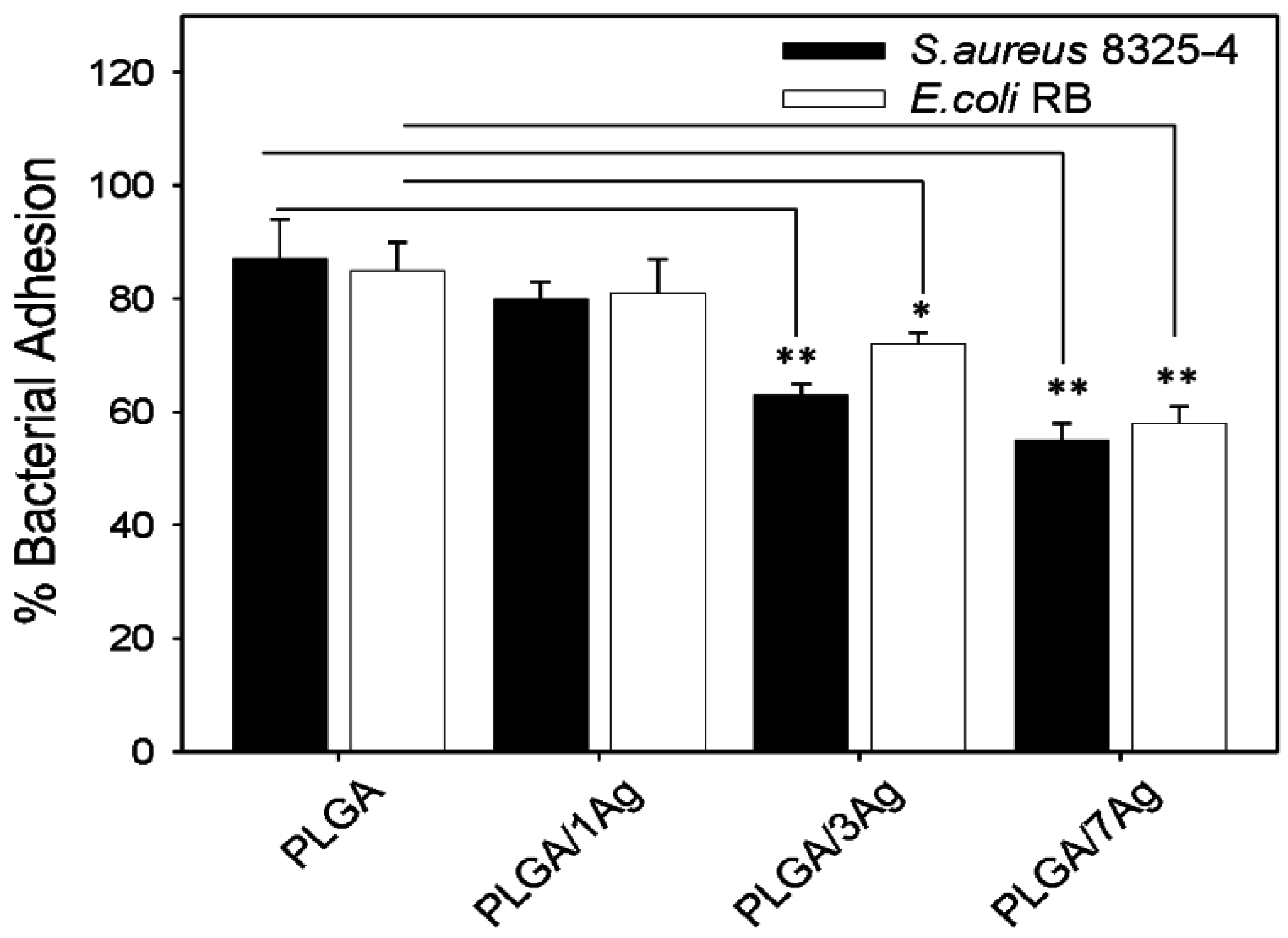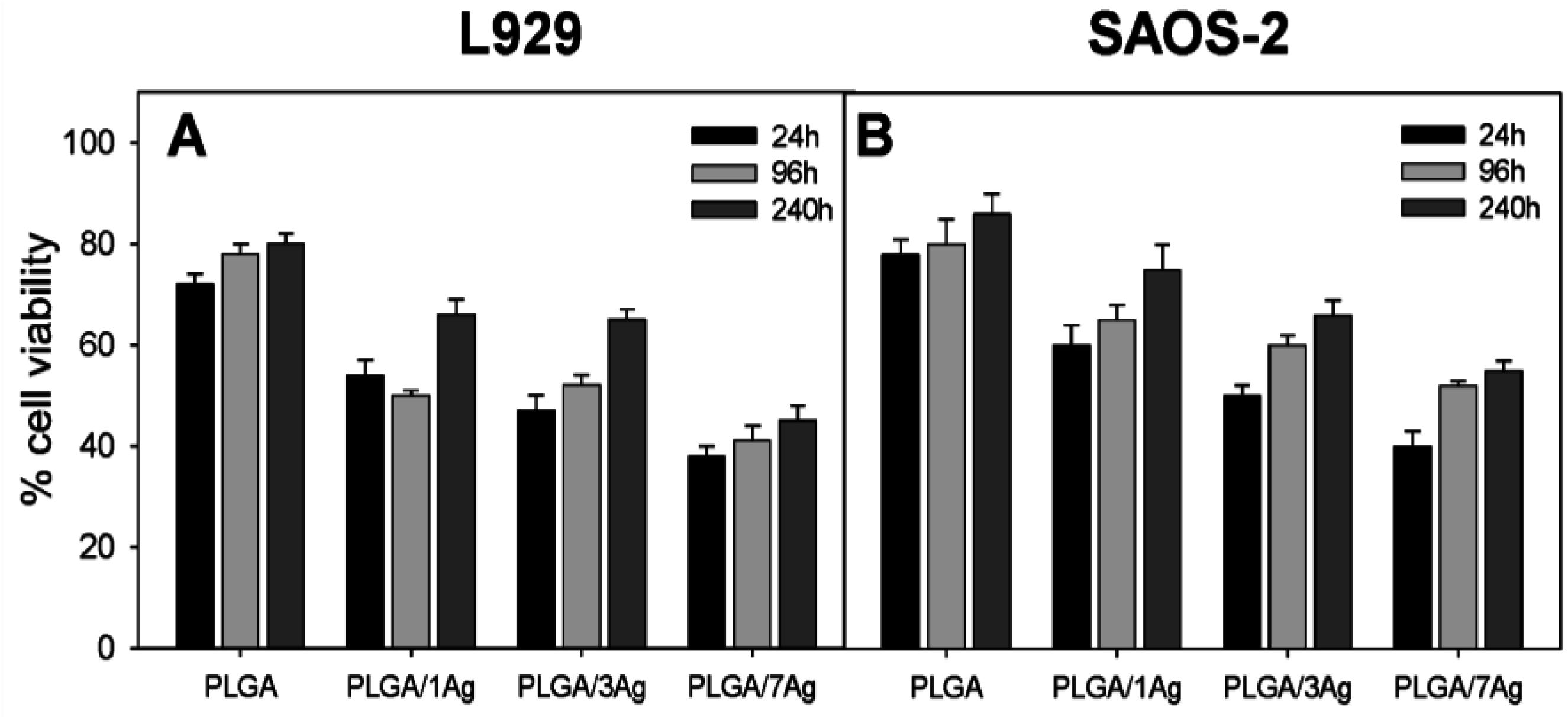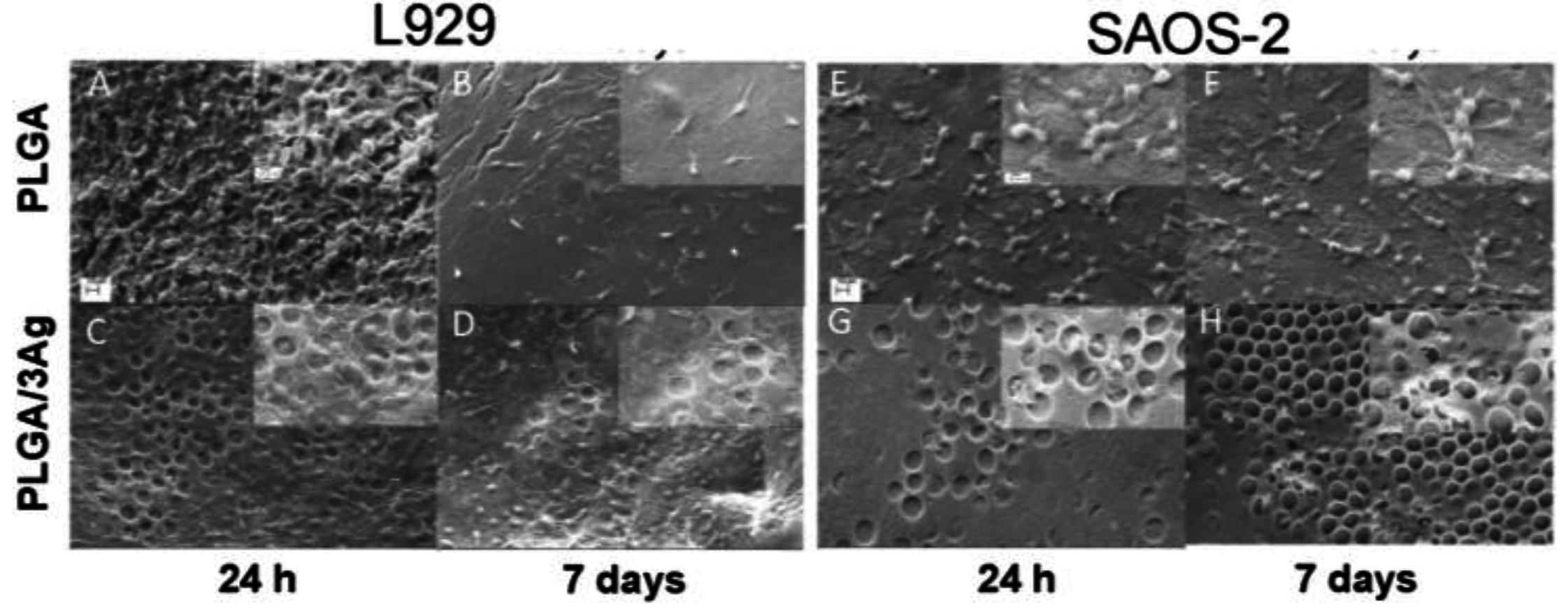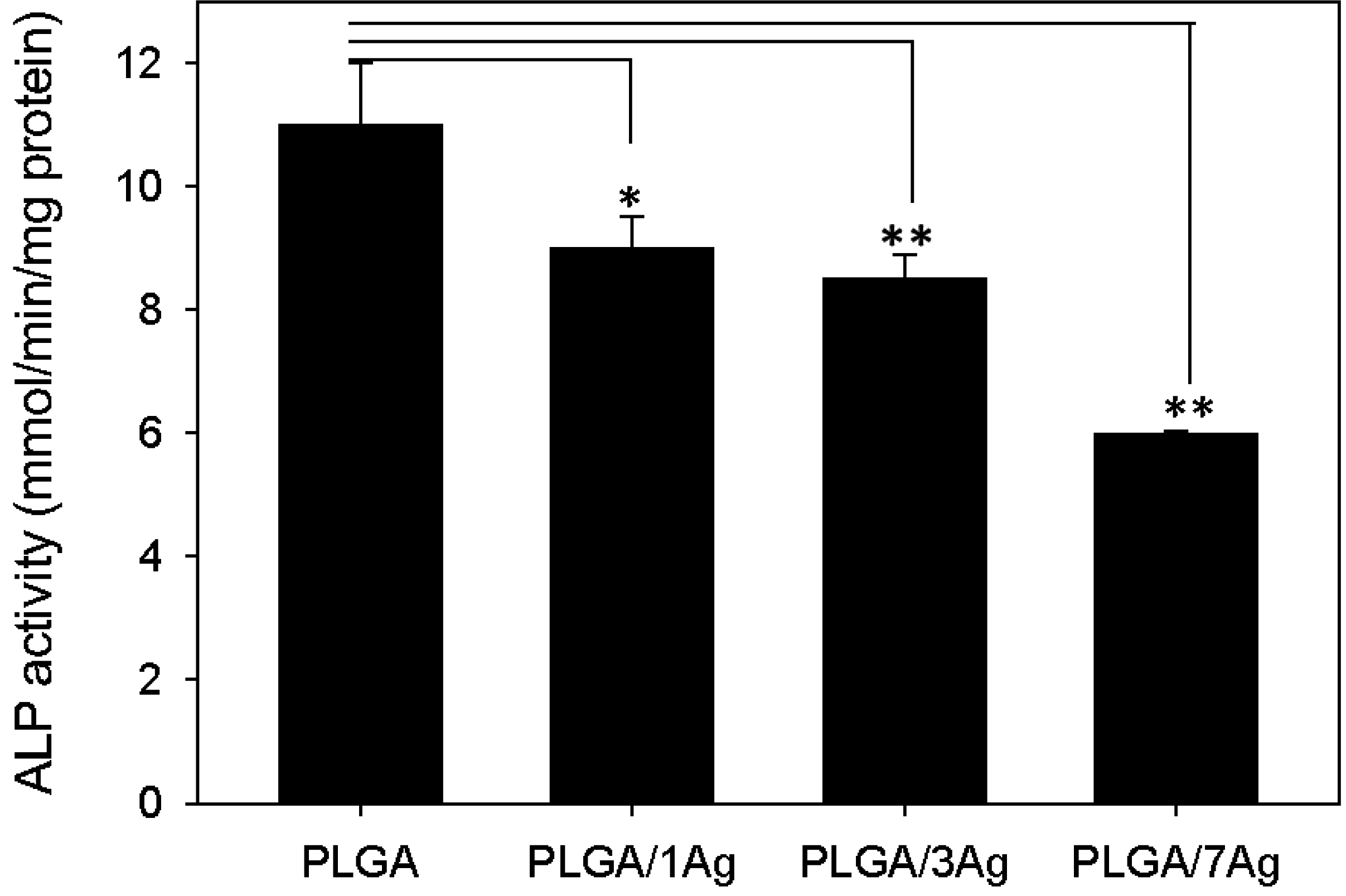Antimicrobial Properties and Cytocompatibility of PLGA/Ag Nanocomposites
Abstract
:1. Introduction
2. Results
2.1. Film Characterization

2.2. In Vitro Antimicrobial Properties of Ag Nanoparticles


2.3. In Vitro Effect of Ag Nanoparticles on Cell Viability and Morphology


2.4. In Vitro Effect of Ag Nanoparticles on Extracellular Matrix (ECM) Deposition by L929 and SAOS-2 Cells
| Matrix Protein Deposition after 10 d of Cell Culture Expressed as pg/(Cell × Sample) | ||||
|---|---|---|---|---|
| Samples | Fibronectin (Fn) | Ratio Fn PLGA Containing Ag/PLGA | Type I Collagen (Col) | Ratio Col PLGA Containing Ag/PLGA |
| PLGA/PLGA | 5.4 ± 0.2 | 1 | 8.4 ± 0.2 | 1 |
| PLGA/1Ag | 4.5 ± 0.1 | 0.83 | 7.3 ± 0.3 | 0.86 |
| PLGA/3Ag | 4.2 ± 0.3 | 0.77 | 6.6 ± 0.4 | 0.75 |
| PLGA/7Ag | 3.4 ± 0.1 | 0.62 | 5.1 ± 0.1 | 0.61 |
| Matrix Protein Deposition after 10 d of Cell Culture Expressed as pg/(cell × well) | |||||||
|---|---|---|---|---|---|---|---|
| Samples | PLGA | PLGA/1Ag | Ratio PLGA/1Ag and PLGA | PLGA/3Ag | Ratio PLGA/3Ag and PLGA | PLGA/7Ag | Ratio PLGA/7Ag and PLGA |
| Alkaline Phosphatase | 2.9 ± 0.2 | 2.9 ± 0.5 | 1.00 | 3.0 ± 0.1 | 1.03 | 2.2 ± 0.2 | 0.75 |
| Decorin | 14.0 ± 0.1 | 15.0 ± 0.3 | 1.07 | 11.2 ± 1.2 | 0.80 | 10.5 ± 0.1 | 0.80 |
| Fibronectin | 0.9 ± 2.8 | 0.5 ± 0.1 | 0.53 | 0.3 ± 1.2 | 0.33 | 0.49 ± 0.01 | 0.55 |
| Osteocalcin | 1.68 ± 0.1 | 0.72 ± 0.02 | 0.42 | 0.9 ± 1.2 | 0.53 | 1.0 ± 0.2 | 0.59 |
| Osteonectin | 2.5 ± 0.3 | 1.4 ± 0.2 | 0.55 | 2.5 ± 0.3 | 1.02 | 1.71 ± 0.02 | 0.69 |
| Osteopontin | 15.1 ± 0.3 | 9.0 ± 0.4 | 0.59 | 8.8 ± 1.1 | 0.58 | 4.5 ± 1.2 | 0.29 |
| Type-I collagen | 20.0 ± 1.0 | 17.5 ± 1.4 | 0.87 | 14.5 ± 1.9 | 0.72 | 12.7 ± 1.1 | 0.63 |
| Type-III collagen | 2.7 ± 0.1 | 3.7 ± 0.1 | 1.36 | 3.0 ± 0.2 | 1.09 | 1.90 ± 0.11 | 0.69 |

3. Discussion
4. Experimental Section
4.1. Materials
4.2. Development and Characterization of Ag Nanocomposite Films
4.3. In Vitro Bacterial Assays on PLGA and PLGA/Ag Nanocomposites
4.3.1. Bacterial Strains and Culture Conditions
4.3.2. Bacterial Adhesion Assay
4.3.3. Antibacterial Activity
4.4. In Vitro Cell Assays on PLGA and PLGA/Ag Nanocomposites
4.4.1. Cell Types and Culture Growth Conditions
4.4.2. Cell Seeding and Culture
4.4.3. 3-(4,5-Dimethylthiazole-2-yl)-2,5-Diphenyl Tetrazolium Bromide Test
4.4.4. DNA Content
4.4.5. Scanning Electron Microscopy (SEM) Analysis
4.4.6. Purified Proteins
4.4.7. Polyclonal Antisera
4.4.8. Extraction of the Extracellular Matrix Proteins from the Cultured Scaffolds and ELISA Assay
4.4.9. Alkaline Phosphatase (ALP) Activity
4.5. Statistical Methods
5. Conclusions
Acknowledgments
Author Contributions
Conflicts of Interest
References
- Armentano, I.; Dottori, M.; Fortunati, E.; Mattioli, S.; Kenny, J.M. Biodegradable polymer matrix nanocomposites for tissue engineering: A review. Polym. Degrad. Stab. 2010, 95, 2126–2146. [Google Scholar] [CrossRef]
- Tjong, S.C. Structural and mechanical properties of polymer nanocomposites. Mater. Sci. Eng. R. 2006, 53, 73–197. [Google Scholar] [CrossRef]
- Schaefer, D.W.; Justice, R.S. How nano are nanocomposites? Macromolecules 2007, 40, 8501–8517. [Google Scholar] [CrossRef]
- Legeay, G.; Poncin-Epaillard, F.; Arciola, C.R. New surfaces with hydrophilic/hydrophobic characteristics in relation to (no) bioadhesion. Int. J. Artif. Organs 2006, 29, 453–461. [Google Scholar]
- Arciola, C.R.; Caramazza, R.; Pizzoferrato, A. In vitro adhesion of Staphylococcus epidermidis on heparin-surface-modified intraocular lenses. J. Cataract. Refract. Surg. 1994, 20, 158–161. [Google Scholar] [CrossRef]
- Rai, M.; Yadav, A.; Gade, A. Silver nanoparticles as a new generation of antimicrobials. Biotechnol. Adv. 2009, 27, 76–83. [Google Scholar] [CrossRef] [PubMed]
- Landsdown, A.B.G. Silver I: Its antibacterial properties and mechanism of action. J. Wound Care 2002, 11, 125–138. [Google Scholar] [CrossRef] [PubMed]
- Castellano, J.J.; Shafii, S.M.; Ko, F.; Donate, G.; Wright, T.E.; Mannari, R.J.; Payne, W.G.; Smith, D.J.; Robson, M.C. Comparative evaluation of silver-containing antimicrobial dressings and drugs. Int. Wound J. 2007, 4, 14–122. [Google Scholar] [CrossRef] [PubMed]
- Taglietti, A.; Arciola, C.R.; D’Agostino, A.; Dacarro, G.; Montanaro, L.; Campoccia, D.; Cucca, L.; Vercellino, M.; Poggi, A.; Pallavicini, P.; et al. Antibiofilm activity of a monolayer of silver nanoparticles anchored to an amino-silanized glass surface. Biomaterials 2014, 35, 1779–1788. [Google Scholar] [CrossRef] [PubMed]
- Eckhardt, S.; Brunetto, P.S.; Gagnon, J.; Priebe, M.; Giese, B.; Fromm, K.M. Nanobio silver: Its interactions with peptides and bacteria, and its uses in medicine. Chem. Rev. 2013, 113, 4708–4754. [Google Scholar] [CrossRef] [PubMed]
- Prabhu, S.; Poulose, E.K. Silver nanoparticles: Mechanism of antimicrobial action, synthesis, medical applications, and toxicity effects. Int. Nano Lett. 2012, 2. [Google Scholar] [CrossRef]
- Panacek, A.; Kvitek, L.; Prucek, R.; Kolar, M.; Vecerova, R.; Pizurova, N.; Sharma, V.K.; Nevecna, T.; Zboril, R. Silver colloid nanoparticles: Synthesis, characterization, and their antibacterial activity. J. Phys. Chem. B 2006, 110, 16248–16253. [Google Scholar] [CrossRef] [PubMed]
- Morones, J.R.; Elechiguerra, J.L.; Camacho, A.; Holt, K.; Kouri, J.B.; Ramirez, J.T.; Yacaman, M.J. The bactericidal effect of silver nanoparticles. Nanotechnology 2005, 16, 2346–2353. [Google Scholar] [CrossRef] [PubMed]
- Baker, C.; Pradhan, A.; Pakstis, L.; Pochan, D.J.; Shah, S.I. Synthesis and antibacterial properties of silver nanoparticles. J. Nanosci. Technol. 2005, 5, 244–249. [Google Scholar] [CrossRef]
- Falletta, E.; Bonini, M.; Fratini, E.; lo Nostro, A.; Pesavento, G.; Becheri, A.; lo Nostro, P.; Canton, P.; Baglioni, P. Clusters of poly(acrylates) and silver nanoparticles: Structure and applications for antimicrobial fabrics. J. Phys. Chem. C 2008, 112, 11758–11766. [Google Scholar] [CrossRef]
- Evanoff, D.D., Jr.; Chumanov, G. Synthesis and optical properties of silver nanoparticles and arrays. Chem. Phys. Chem. 2005, 6, 1221–1231. [Google Scholar] [CrossRef] [PubMed]
- Campoccia, D.; Montanaro, L.; Arciola, C.R. A review of the biomaterials technologies for infection-resistant surfaces. Biomaterials 2013, 34, 8533–8554. [Google Scholar] [CrossRef] [PubMed]
- Lee, J.Y.; Nagahata, J.L.R.; Horiuchi, S. Effect of metal nanoparticles on thermal stabilization of polymer/metal nanocomposites prepared by a one-step dry process. Polymer 2006, 47, 7970–7979. [Google Scholar] [CrossRef]
- Ma, P.X. Scaffold for Tissue Engineering. Mater. Today 2004, 7, 30–40. [Google Scholar] [CrossRef]
- Park, G.E.; Pattison, M.A.; Park, K.; Webster, T.J. Accelerated chondrocyte functions on NaOH-treated PLGA scaffolds. Biomaterials 2005, 26, 3075–3086. [Google Scholar] [CrossRef] [PubMed]
- Campoccia, D.; Montanaro, L.; Arciola, C.R. A review of the clinical implications of anti-infective biomaterials and infection-resistant surfaces. Biomaterials 2013, 34, 8018–8029. [Google Scholar] [CrossRef] [PubMed]
- Fortunati, E.; Latterini, L.; Rinaldi, S.; Kenny, J.M.; Armentano, I. PLGA/Ag nanocomposites: In vitro degradation study and silver ion release. J. Mater. Sci. Mater. Med. 2011, 22, 2735–2744. [Google Scholar] [CrossRef] [PubMed]
- Armentano, I.; Kenny, J.M. Silver Nanoparticles: Synthesis, Uses and Health Concerns; Armentano, I., Kenny, J.M., Eds.; Nova Science Publishers: New York, NY, USA, 2013; Chapters 8, 14, and 18. [Google Scholar]
- De Lima, R.; Seabra, A.B.; Durán, N. Silver nanoparticles: A brief review of cytotoxicity and genotoxicity of chemically and biogenically synthesized nanoparticles. J. Appl. Toxicol. 2012, 32, 867–879. [Google Scholar] [CrossRef] [PubMed]
- Hadrupa, V.; Lamb, H.R. Oral toxicity of silver ions, silver nanoparticles and colloidal silver—A review. Regul. Toxicol. Pharmacol. 2014, 68, 1–192. [Google Scholar] [CrossRef] [PubMed]
- Armentano, I.; Fortunati, E.; Latterini, L.; Rinaldi, S.; Saino, E.; Visai, L.; Elisei, F.; Kenny, J.M. Biodegradable PLGA matrix nanocomposite with silver nanoparticles: Material properties and bacteria activity. J. Nanostruct. Polym. Nanocomp. 2010, 6, 110–117. [Google Scholar]
- Fortunati, E.; Mattioli, S.; Visai, L.; Imbriani, M.; Fierro, J.L.G.; Kenny, J.M.; Armentano, I. Combined effects of Ag nano-particles and oxygen plasma treatment on PLGA morphological, chemical, and antibacterial properties. Biomacromolecules 2013, 14, 626–636. [Google Scholar] [CrossRef] [PubMed]
- Agarwal, A.; Weis, T.L.; Schurr, M.J.; Faith, N.G.; Czuprynski, C.J.; McAnulty, J.F.; Murphy, C.J.; Abbott, N.L. Surfaces modified with nanometer-thick silver-impregnated polymeric films that kill bacteria but support growth of mammalian cells. Biomaterials 2010, 31, 680–690. [Google Scholar] [CrossRef] [PubMed]
- An, Y.H.; Friedman, R.J. Concise review of mechanisms of bacterial adhesion to biomaterial surfaces. J. Biomed. Mater. Res. 1998, 43, 338–348. [Google Scholar] [CrossRef]
- Damm, C.; Münstedt, H.; Rösch, A. The Antimicrobial Efficacy of Polyamide 6/Silver-Nano and Microcomposites. Mater. Chem. Phys. 2008, 108, 61–66. [Google Scholar] [CrossRef]
- Monteiro, D.R.; Gorup, L.F.; Takamiya, A.S.; Ruvollo-Filho, A.C.; de Camargo, E.R.; Barbosa, D.B. The growing importance of materials that prevent microbial adhesion: Antimicrobial effect of medical devices containing silver. Int. J. Antimicrob. Agents 2009, 34, 103–110. [Google Scholar] [CrossRef] [PubMed]
- Williams, D.F. The Williams Dictionary of Biomaterials; Liverpool University Press: Liverpool, UK, 1999. [Google Scholar]
- Anderson, H.C.; Hsu, H.H.T.; Raval, P.; Reynold, P.R.; Gurley, D.J.; Aguilera, M.X.; Davis, L.S.; Moylan, P.E. Bone-inducing agent in Saos-2 cell extracts and secretions. Cells Mater. 1998, 8, 89–98. [Google Scholar]
- Anderson, H.C.; Reynolds, P.R.; Hsu, H.H.; Missana, L.; Masuhara, K.; Moylan, P.E.; Roach, H.I. Selective synthesis of bone morphogenetic proteins-1, -3, -4 and bone sialoprotein may be important for osteoinduction by Saos-2 cells. J. Bone Miner. Metab. 2002, 20, 73–82. [Google Scholar] [CrossRef] [PubMed]
- Anderson, H.C.; Sugamoto, K.; Morris, D.C.; Hsu, H.H.; Hunt, T. Bone-inducing agent(BIA) from cultured human Saos-2 osteosarcoma cells. Bone Miner. 1992, 16, 49–62. [Google Scholar] [CrossRef]
- Anderson, H.C.; Hsu, H.H.; Raval, P.; Hunt, T.R.; Schwappach, J.R.; Morris, D.C.; Schneider, D.J. The mechanism of bone induction and bone healing by human osteosarcoma cell extracts. Clin. Orthop. Relat. Res. 1995, 313, 129–134. [Google Scholar] [CrossRef]
- Akiyama, S.K.; Yamada, K.M. Fibronectin. Adv. Enzymol. Relat. Areas Mol. Biol. 1987, 59, 1–57. [Google Scholar] [PubMed]
- Humphries, M.J.; Obara, M.; Olden, K.; Yamada, K.M. Role of fibronectin in adhesion, migration, and metastasis. Cancer Investig. 1989, 7, 373–393. [Google Scholar] [CrossRef]
- Larsen, M.; Artym, V.V.; Green, J.A.; Yamada, K.M. The matrix reorganized: Extracellular matrix remodeling and integrin signaling. Curr. Opin. Cell Biol. 2006, 18, 463–471. [Google Scholar] [CrossRef] [PubMed]
- Burgeson, R.E.; Nimni, M.E. Collagen types. Molecular structure and tissue distribution. Clin. Orthop. Relat. Res. 1992, 282, 250–272. [Google Scholar] [PubMed]
- Manolagas, S.C. Birth and death of bone cells: Basic regulatory mechanisms and implications for the pathogenesis and treatment of osteoporosis. Endocr. Rev. 2000, 21, 115–137. [Google Scholar] [CrossRef] [PubMed]
- Torii, Y.; Hitomifl, K.; Yamagishi, Y.; Tsukagoshi, N. Demonstration of alkaline phosphatase participation in the mineralization of osteoblasts by antisense RNA approach. Cell Biol. Int. 1996, 20, 459–464. [Google Scholar] [CrossRef] [PubMed]
- Zimmermann, R.; Pfuch, A.; Horn, K.; Weisser, J.; Heft, A.; Roder, M.; Linke, R.; Schnabelrauch, M.; Schimanski, A. An approach to create silver containing antibacterial coatings by use of atmospheric pressure plasma chemical vapour deposition (APCVD) and combustion chemical vapour deposition (CCVD) in an economic way. Plasma Process. Polym. 2011, 8, 295–304. [Google Scholar] [CrossRef]
- Petrini, P.; Arciola, C.R.; Pezzali, I.; Bozzini, S.; Montanaro, L.; Tanzi, M.C.; Speziale, P.; Visai, L. Antibacterial activity of zinc modified titanium oxide surface. Int. J. Artif. Organs 2006, 29, 434–442. [Google Scholar] [PubMed]
- Saino, E.; Maliardi, V.; Quartarone, E.; Fassina, L.; Benedetti, L.; de Angelis, M.G.; Mustarelli, P.; Facchini, A.; Visai, L. In vitro enhancement of SAOS-2 cell calcified matrix deposition onto radio frequency magnetron sputtered bioglass-coated titanium scaffolds. Tissue Eng. A 2010, 16, 995–1008. [Google Scholar] [CrossRef] [PubMed]
- Saino, E.; Grandi, S.; Quartarone, E.; Maliardi, V.; Galli, D.; Bloise, N.; Fassina, L.; de Angelis, M.G.; Mustarelli, P.; Imbriani, M.; et al. In vitro calcified matrix deposition by human osteoblasts onto a zinc-containing bioactive glass. Eur. Cell Mater. 2011, 21, 59–72. [Google Scholar] [PubMed]
- Bloise, N.; Ceccarelli, G.; Minzioni, P.; Vercellino, M.; Benedetti, L.; de Angelis, M.G.; Imbriani, M.; Visai, L. Investigation of low-level laser therapy potentiality on proliferation and differentiation of human osteoblast-like cells in the absence/presence of osteogenic factors. J. Biomed. Opt. 2013, 18. [Google Scholar] [CrossRef] [PubMed]
© 2016 by the authors; licensee MDPI, Basel, Switzerland. This article is an open access article distributed under the terms and conditions of the Creative Commons by Attribution (CC-BY) license (http://creativecommons.org/licenses/by/4.0/).
Share and Cite
Scavone, M.; Armentano, I.; Fortunati, E.; Cristofaro, F.; Mattioli, S.; Torre, L.; Kenny, J.M.; Imbriani, M.; Arciola, C.R.; Visai, L. Antimicrobial Properties and Cytocompatibility of PLGA/Ag Nanocomposites. Materials 2016, 9, 37. https://doi.org/10.3390/ma9010037
Scavone M, Armentano I, Fortunati E, Cristofaro F, Mattioli S, Torre L, Kenny JM, Imbriani M, Arciola CR, Visai L. Antimicrobial Properties and Cytocompatibility of PLGA/Ag Nanocomposites. Materials. 2016; 9(1):37. https://doi.org/10.3390/ma9010037
Chicago/Turabian StyleScavone, Mariangela, Ilaria Armentano, Elena Fortunati, Francesco Cristofaro, Samantha Mattioli, Luigi Torre, Jose M. Kenny, Marcello Imbriani, Carla Renata Arciola, and Livia Visai. 2016. "Antimicrobial Properties and Cytocompatibility of PLGA/Ag Nanocomposites" Materials 9, no. 1: 37. https://doi.org/10.3390/ma9010037
APA StyleScavone, M., Armentano, I., Fortunati, E., Cristofaro, F., Mattioli, S., Torre, L., Kenny, J. M., Imbriani, M., Arciola, C. R., & Visai, L. (2016). Antimicrobial Properties and Cytocompatibility of PLGA/Ag Nanocomposites. Materials, 9(1), 37. https://doi.org/10.3390/ma9010037









